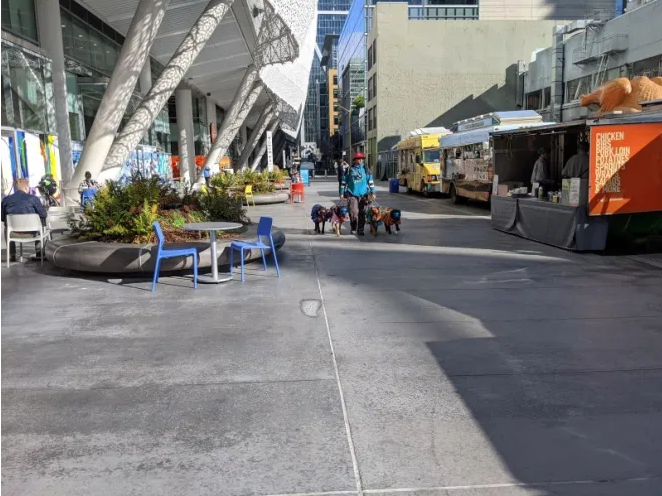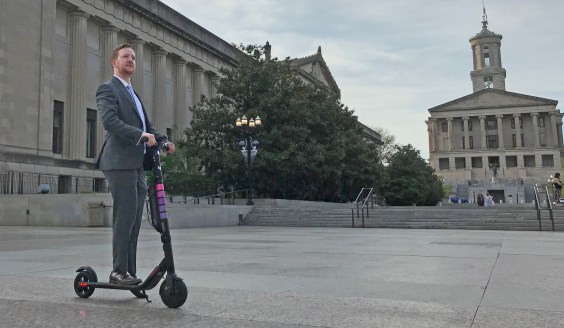Note: GJEL Accident Attorneys regularly sponsors coverage on Streetsblog San Francisco and Streetsblog California. Unless noted in the story, GJEL Accident Attorneys is not consulted for the content or editorial direction of the sponsored content.
The Slow Streets movement started as a response to COVID and the need for more space for recreation while socially distancing. The push is now on to open these streets permanently for people.
Amidst that, it's easy to forget that in January 2020, shortly before COVID became a pandemic, there was a small section of Natoma next to the Salesforce Transit Center, picture above, that was already a "slow street," open for people. But a hotel development adjacent to Natoma wants to build a big parking garage and use that chunk of Natoma for access to it.
Streetsblog covered this back in 2020. But then COVID came, and if fell off the radar.
Fortunately, Livable City's Tom Radulovich kept at it, recently penning a letter to the Board of Supervisors. Here's his intro:
As you consider the proposed Parcel F development before you today, we ask that you take action to preserve the Natoma Plaza, Transbay’s largest remaining car-free public space. The covid pandemic has underlined the importance of car-free public spaces in the life of our community, and it would be tragic to destroy a large car-free public space right next to our regional transit center. The attached letter further details the reasons to save this space. The action you take today will impact this neighborhood, and the transit center, for generations. We ask that you prioritize the long-term needs of community over the short-term desires of capital.
Streetsblog suggests all readers write their own letters, urging that Natoma's one block of open street remain open. This city already dedicates quite enough space to cars. And the last thing the city needs next to the Transit Center is another parking garage.
Hears how to reach out to Supervisor Matt Haney, whose district encompasses the area.
email: matt.haney@sfgov.org
Phone: 415 554-7970
Or find your supervisor HERE.
The full text of the letter is below for readers to crib.
San Francisco Board of Supervisors
City Hall
1 Dr. Carlton B. Goodlett Place
San Francisco CA 94102
Re: Parcel F development (542-550 Howard Street)
Dear Supervisors,
On behalf of Livable City, we urge you to amend the proposed development agreement and rezoning plan for Parcel F (542-550 Howard Street) to preserve and protect the car-free block of Natoma Street between First and Second Streets. Specifically, we asking that you:
- Modify the proposed Parcel F development agreement to keep Natoma Street car-free, and activate the south side of Natoma with people-oriented ground-floor uses
- Amend the Planning Code and Transbay redevelopment plan to prohibit new parking and loading entrances on Natoma Street between Second and First to keep the rest of the block car-free; and
- Amend plans and codes to protect other car-free blocks, including the extension of Clementina and Tehama streets between Main and Beale that will front on the proposed new park.
Together with many other concerned San Franciscans, we spoke up on behalf of Natoma plaza early last year. We met soon thereafter with Supervisor Haney, who assured us of his commitment to car-free public spaces in his district, and promised to keep us informed about the proposed development.
Since then our City has been battered by the coronavirus pandemic. The pandemic has underlined the importance of streets as public spaces, particularly car-free streets. Livable City has worked with communities across the City to establish temporary car-free spaces to foster community, support small business, and enjoy fresh air, sociability, and exercise. Cities around the world are doing the same, in response to the pandemic and to make progress towards even greater challenges like traffic safety, climate and the ecological crisis, and creating more equitable and inclusive cities.
The development before you today replace the car-free block of Natoma Street, between First and Second streets, with a roadway and garage entry. This block of Natoma is currently the longest pedestrianized block in SoMa, and the only pedestrianized block fronting on the Salesforce Transit Center.
If the proposed Parcel F development proceeds as planned, it will irreparably destroy this car-free space. The developer’s current plan proposes extending a roadway through the car-free space to a large new private garage with nearly 200 parking spaces, eliminating most of the block’s car-free space and bringing hundreds of daily car trips to the area. As we know well from our community work, entrances to large private garages effectively preclude even temporary car-free spaces.
The transit center, which re-opened last year, is a spectacular public building. The region spent billions of dollars to build it, and plans to spend billions more to bring Caltrain and high-speed rail service to the transit Center, making it the most important transit hub in Northern California. The transit center is also the public centerpiece of the city’s densest and most transit-rich neighborhood. Our regional transit center and Transbay neighborhood should be complemented by walkable and bikeable streets and people-oriented public spaces.
Unfortunately it isn’t; the streets fronting on the transit center are bleak, dominated by automobile traffic and parking and loading entries.
The car-free Natoma block is both the longest block fronting on the transit center, and currently the only block not dominated by traffic, parking, and loading. There is only one garage entry on the whole block, located at its far western end. For years now most of the block has been a pedestrian plaza, with food trucks lining unbuilt Parcel F. Ground-floor retail spaces in the terminal face the north side of Natoma, and once occupied they will further enhance it as a public space. It’s a rare public pedestrian oasis in an increasingly crowded and automobile-dominated City. We should preserve and enhance it, not destroy it.
Destroying this pedestrian enclave is totally unnecessary. The Parcel F can be developed as a car-free building, and help move the Transbay district and our City towards a more sustainable, less automobiledominated, and more people-oriented future. Parcel F’s location couldn’t be more transit-rich, and couldn’t be a more suitable place for car-free residents to live and car-free hotel guests to stay.
Passenger and freight loading can be accommodated on Howard Street, with a protected bikeway preserving bike access. Any residents or hotel guests who insist on using private cars can park in various nearby buildings, which are over-supplied with parking for such a dense and transit-oriented neighborhood. As the neighborhood continues to get denser and the transit center gets busier, car-free Natoma Street will become an increasingly valuable neighborhood amenity.
Since 2019 the city has been making moves to expand car-free public spaces for the community to enjoy. It would be a tragedy to destroy Transbay’s last car-free public space, and to prioritize the short-term desires of capital over the long-term interests of the community. We urge you to act today to preserve Natoma plaza as this development moves forward.
Sincerely,
Tom Radulovich
Executive Director






